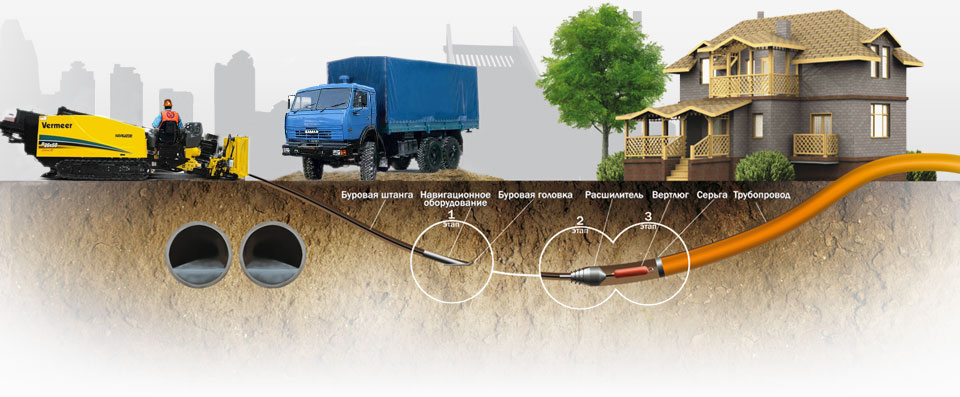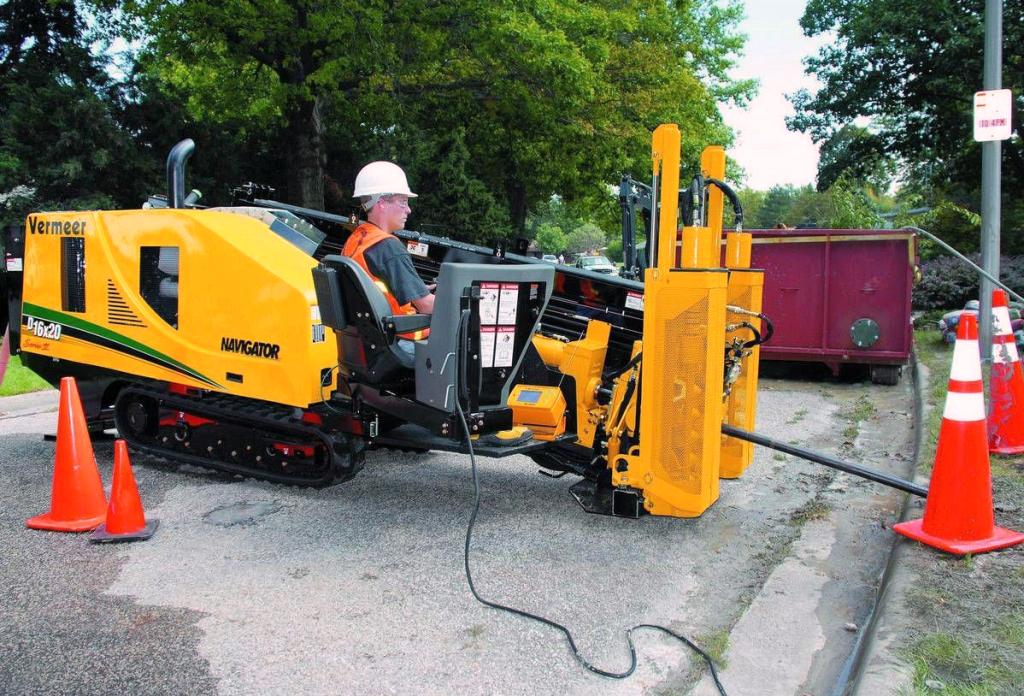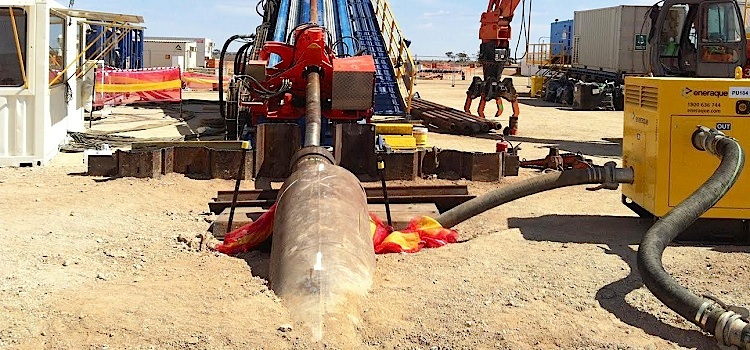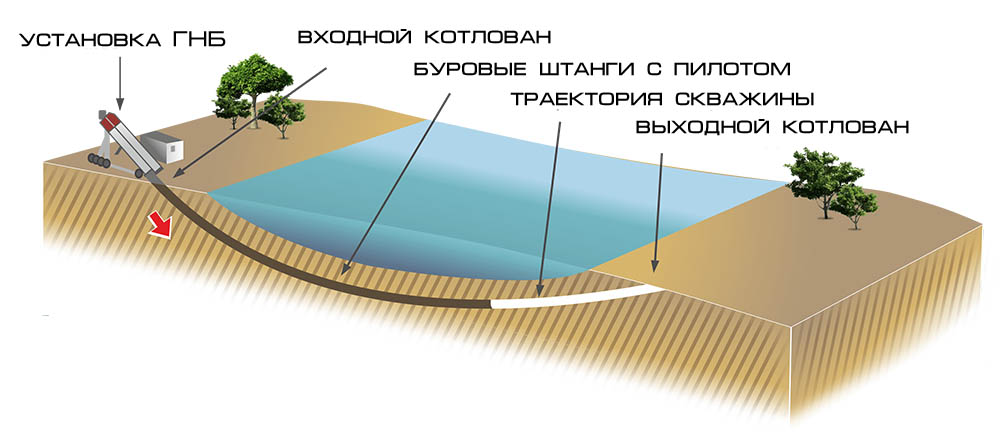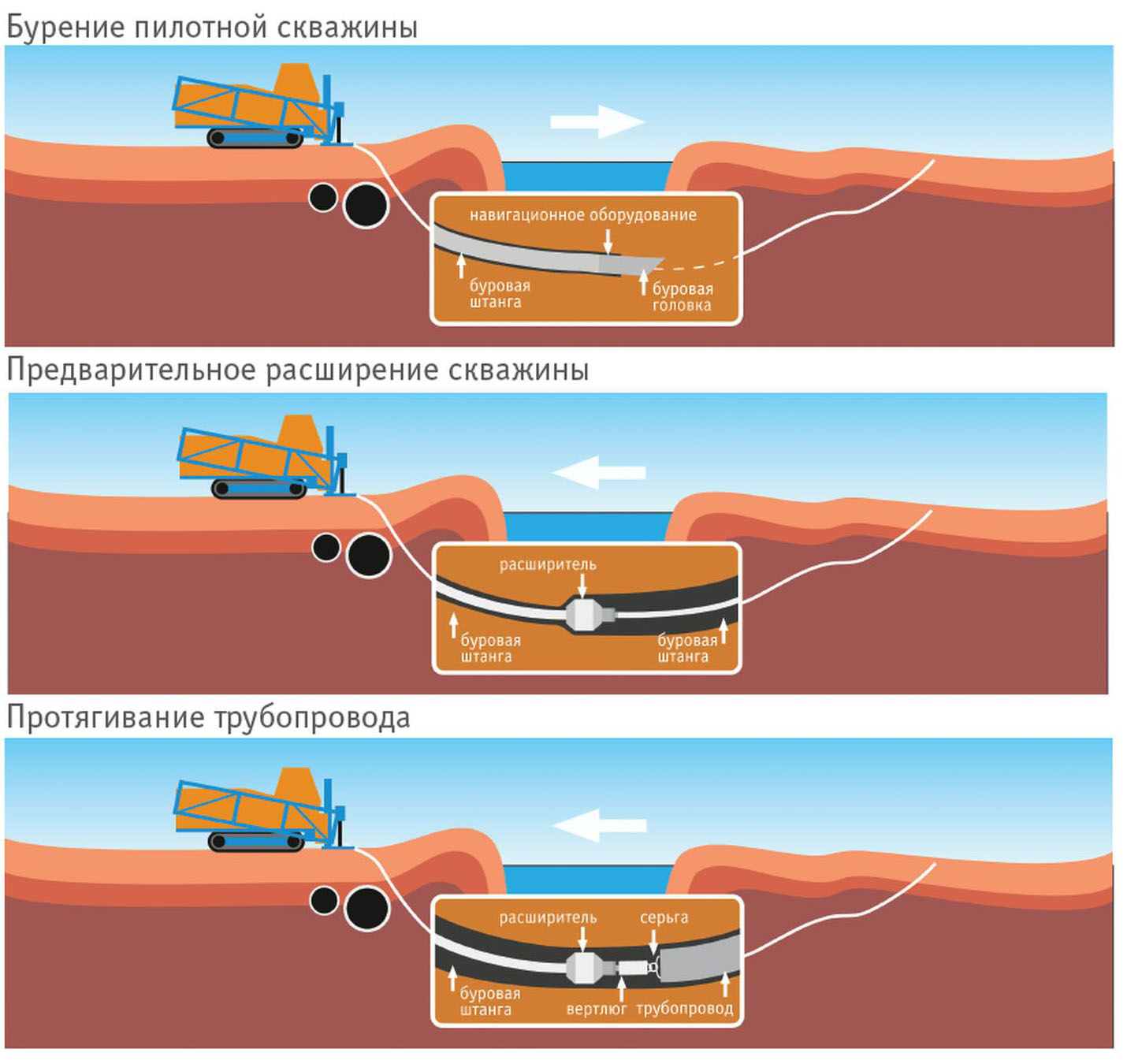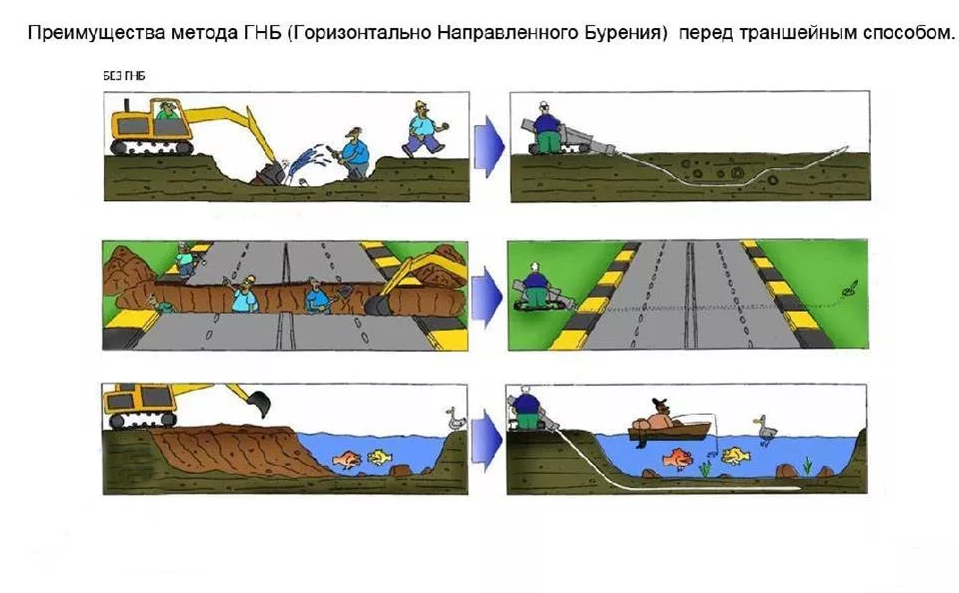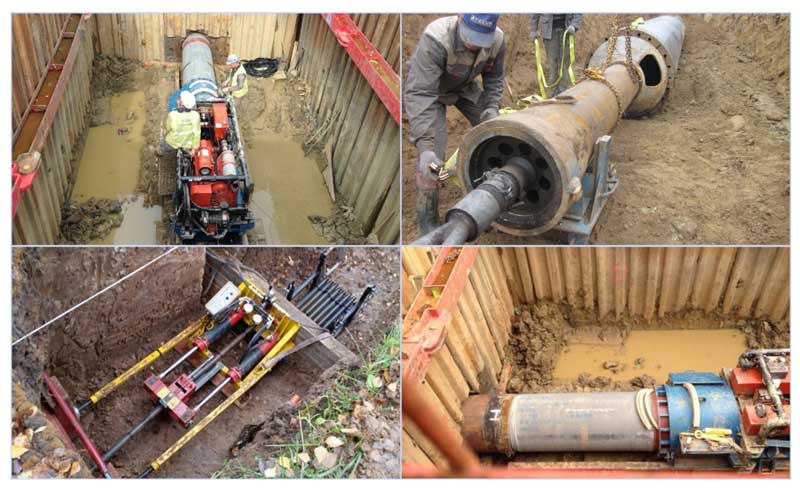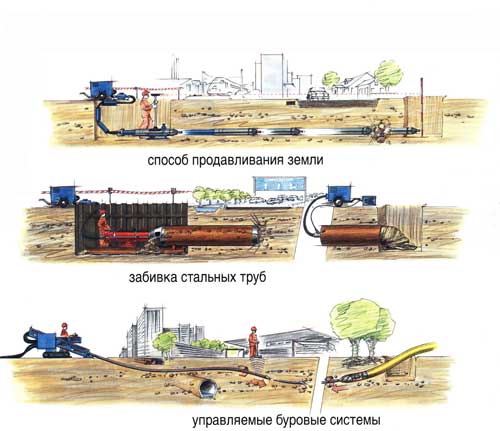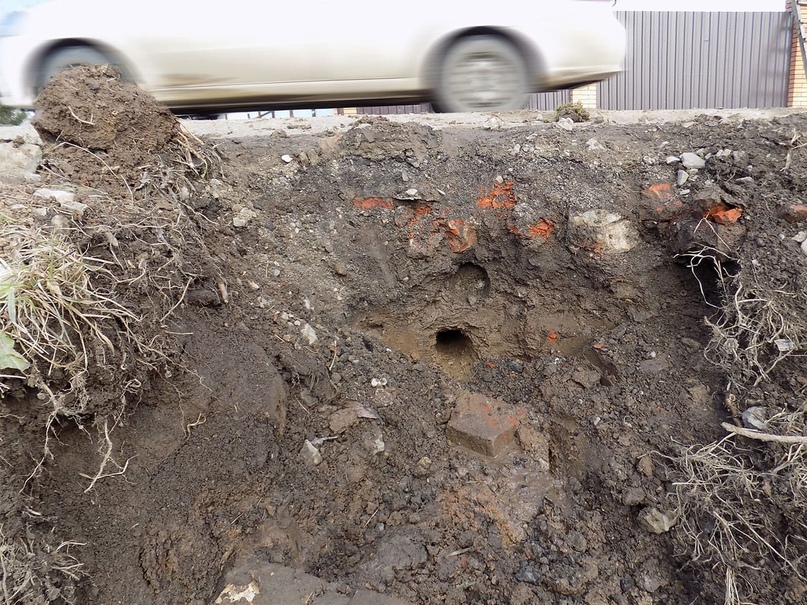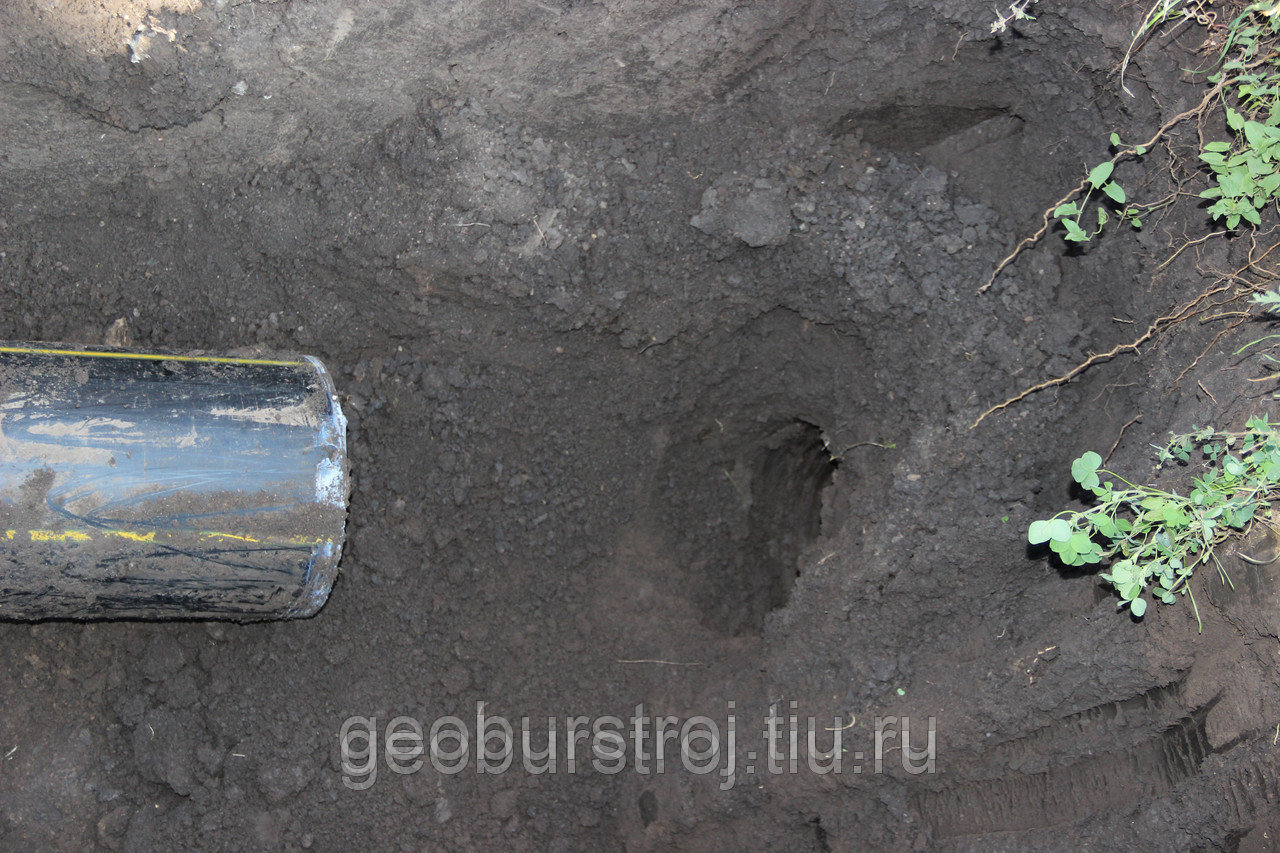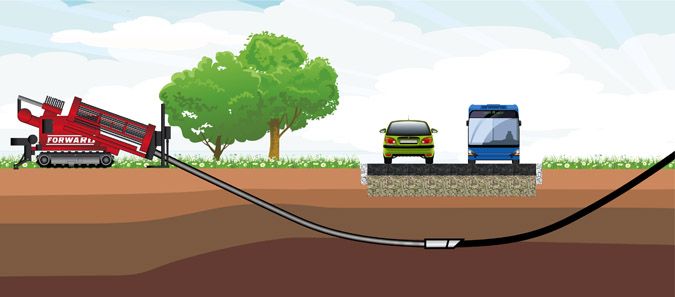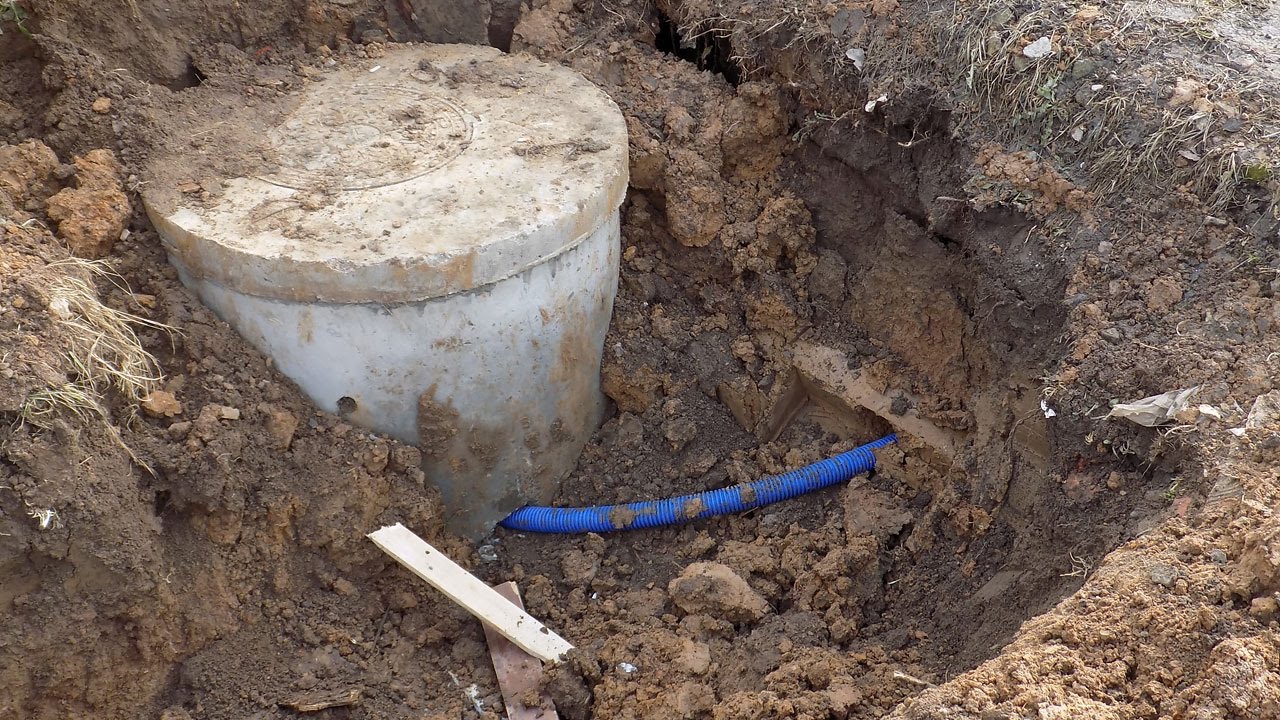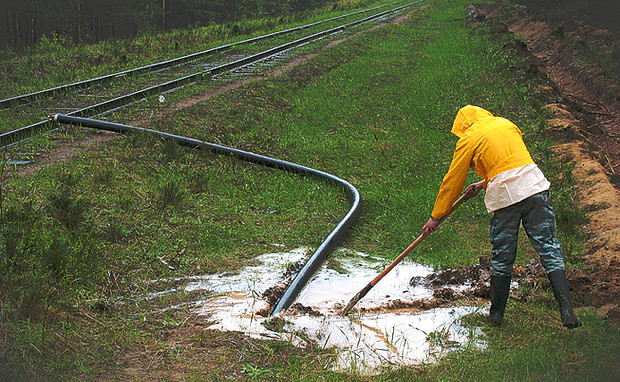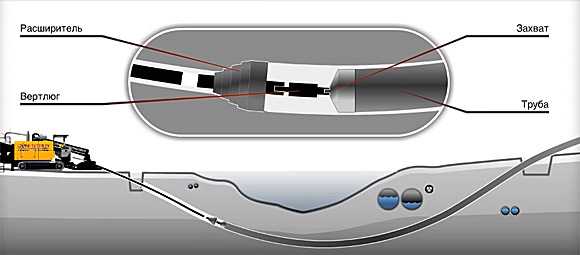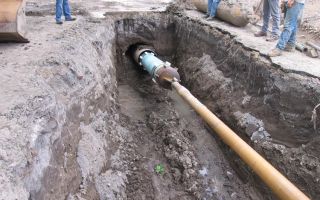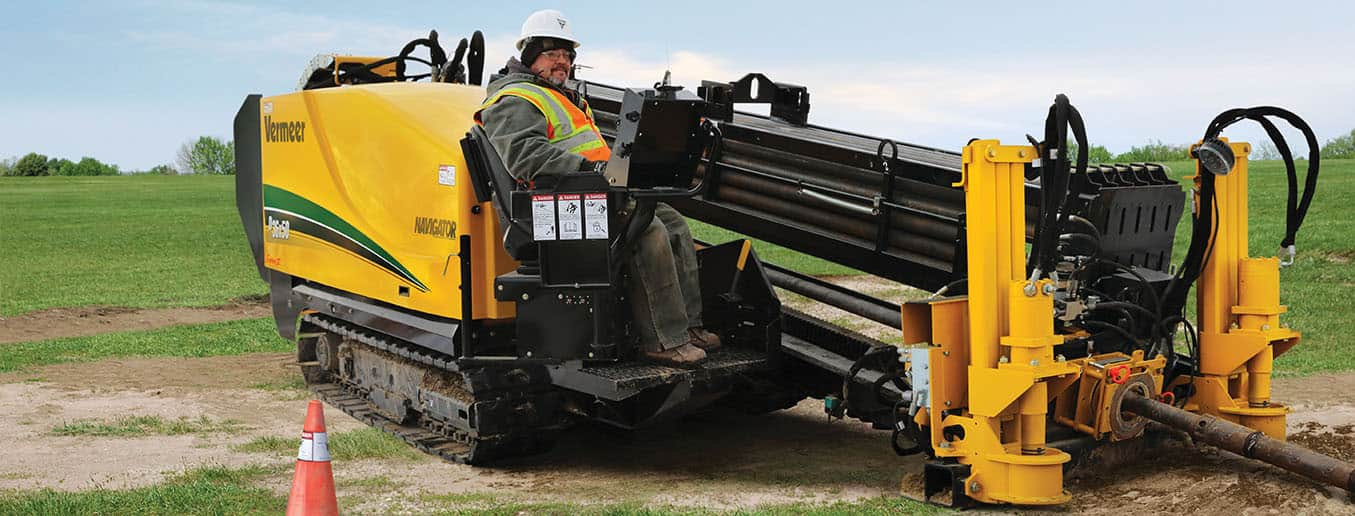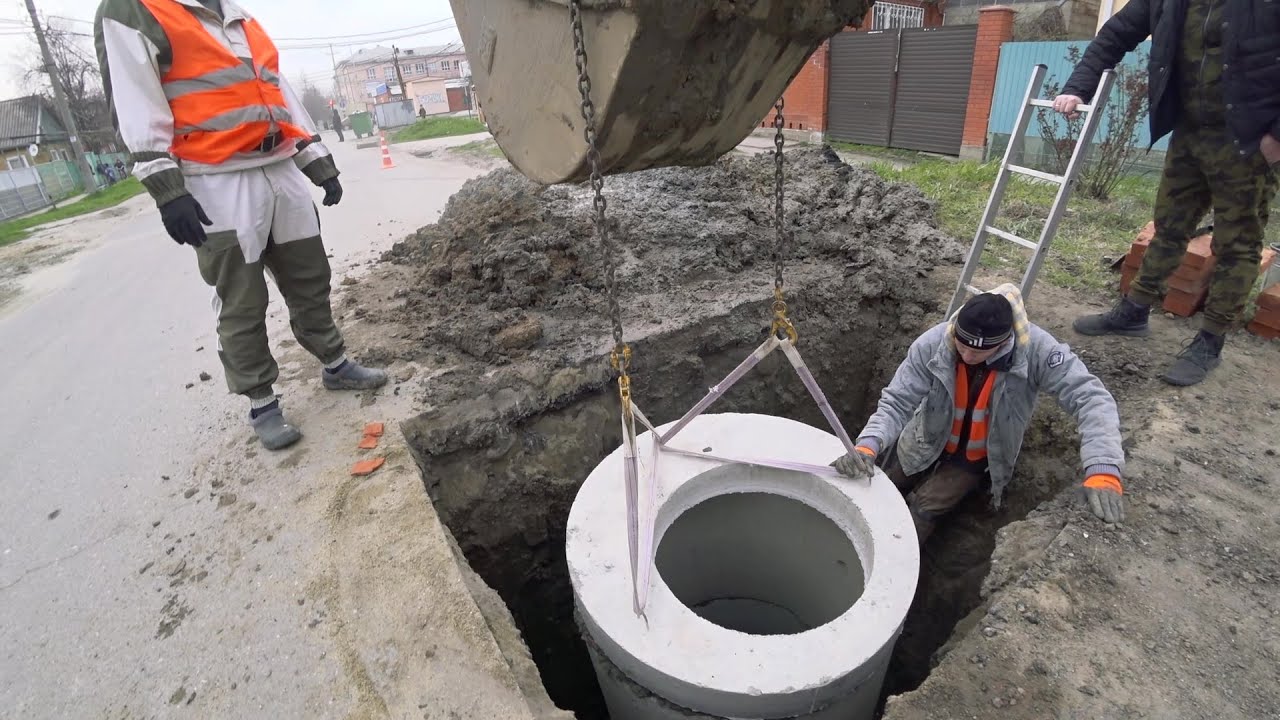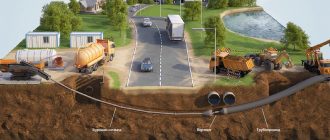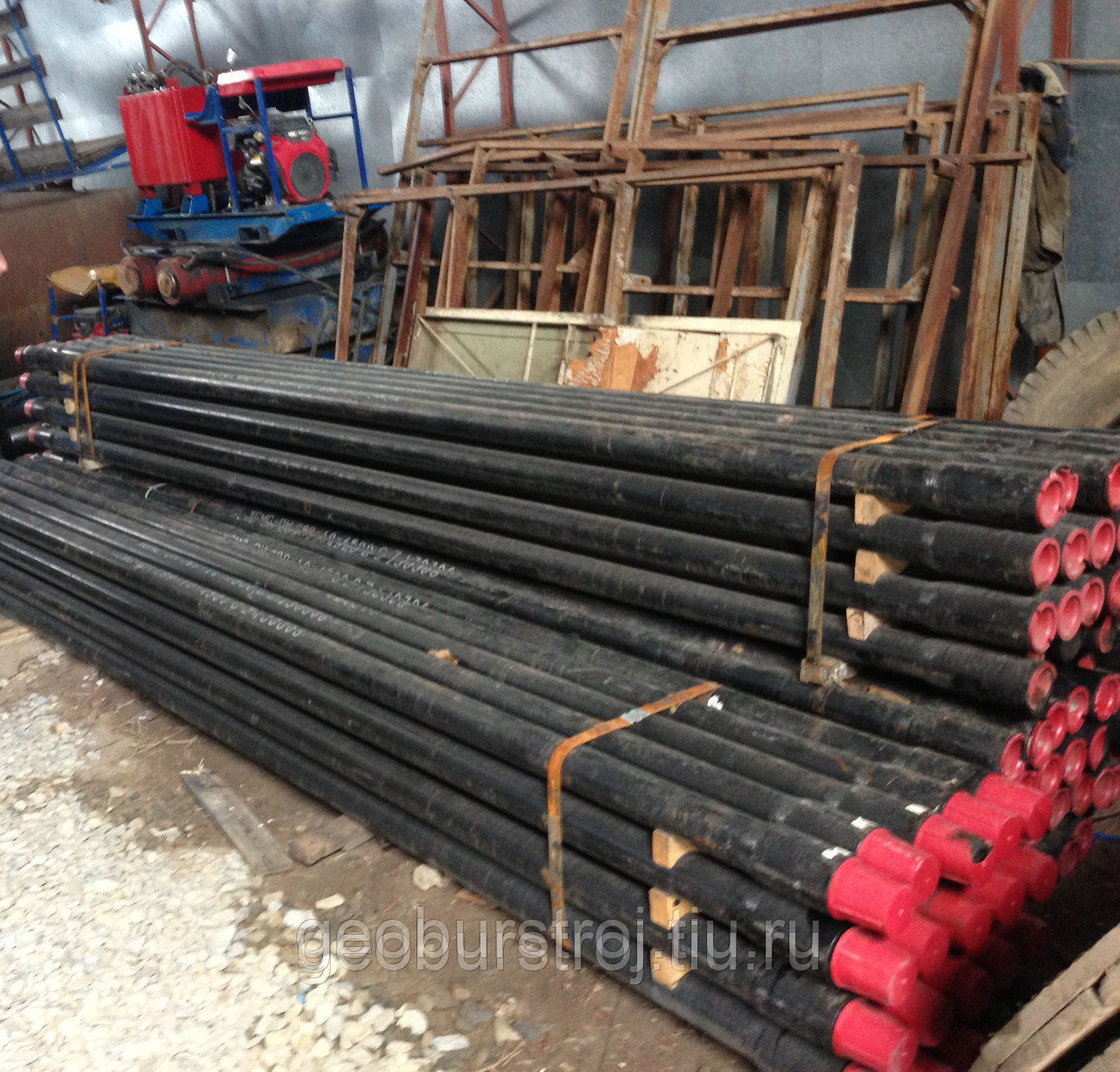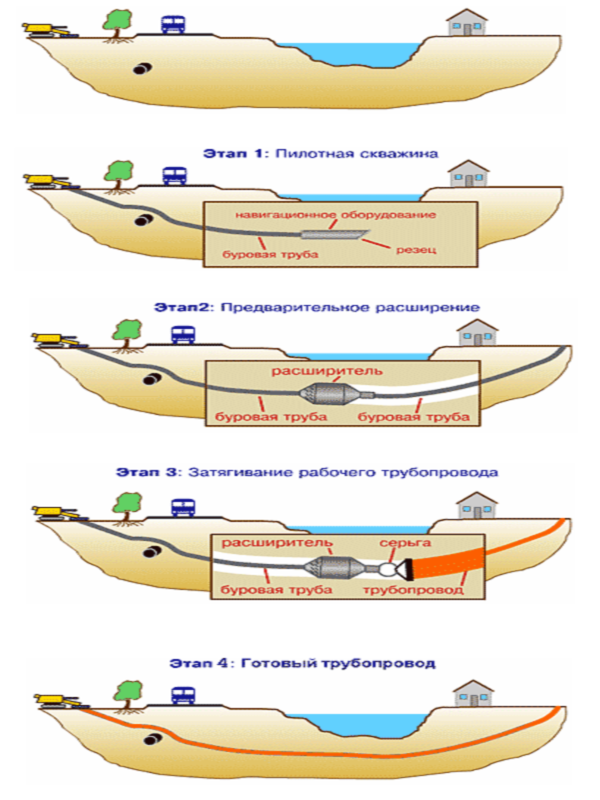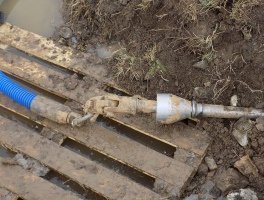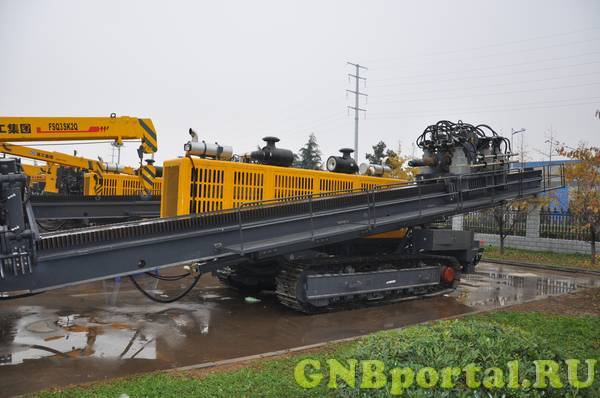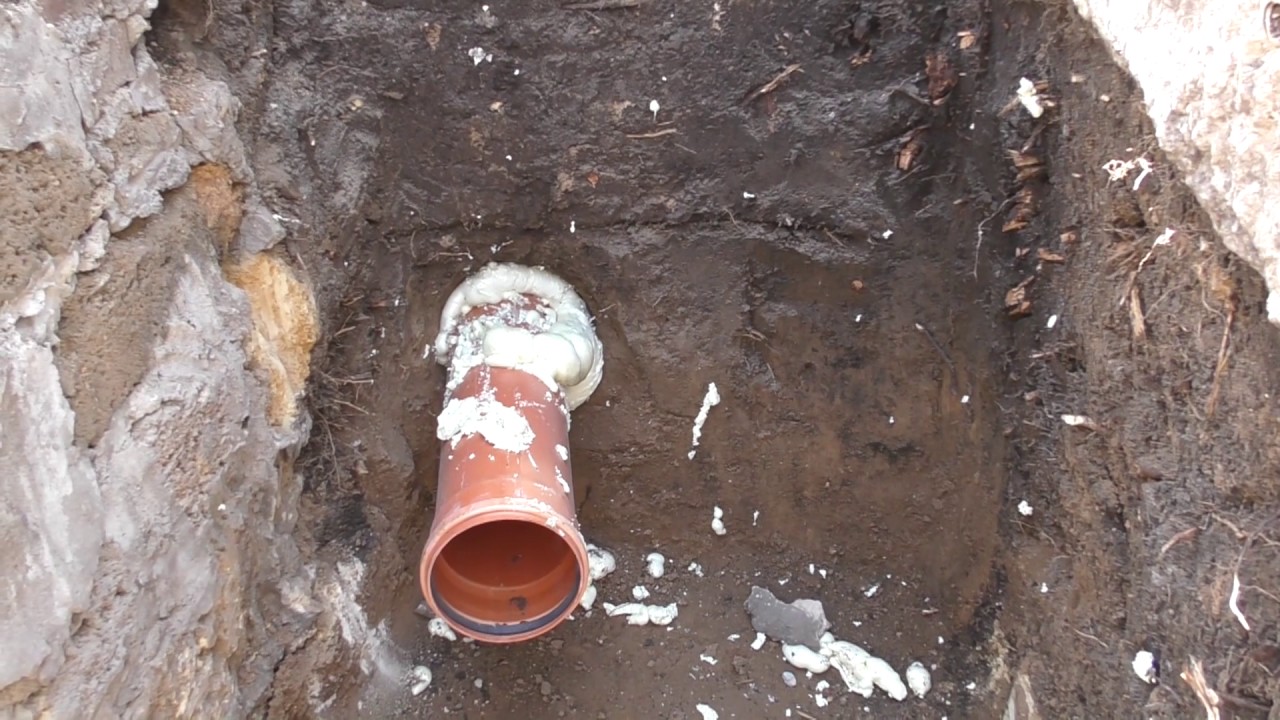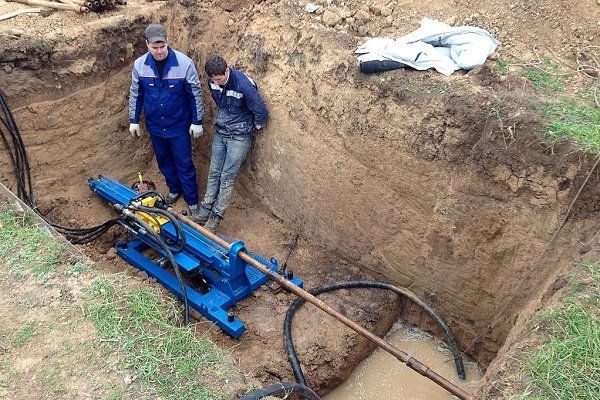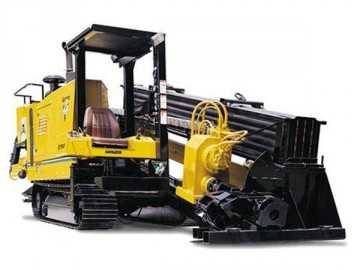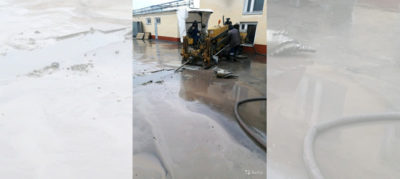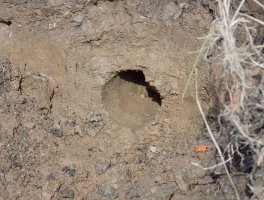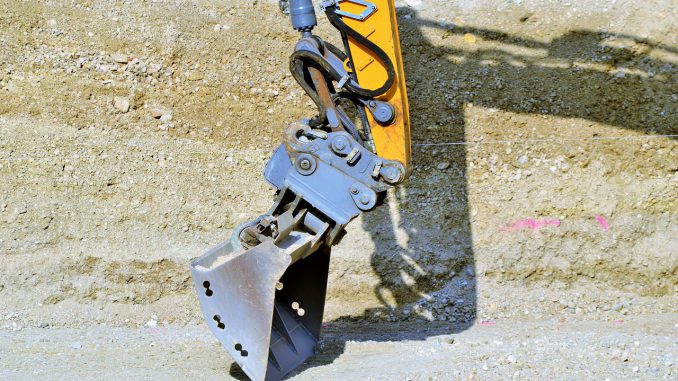Benefits of the horizontal drilling method
Directional wells are widely used in the extraction of oil, gas and any minerals - they allow you to achieve the goal in the shortest possible way, saving time and resources. Also, with the help of inclined and horizontal punctures, underground pipelines and cable lines are being laid to power industrial equipment. This method will be no less useful in construction, and we are talking about both the construction of high-rise buildings and private construction work.
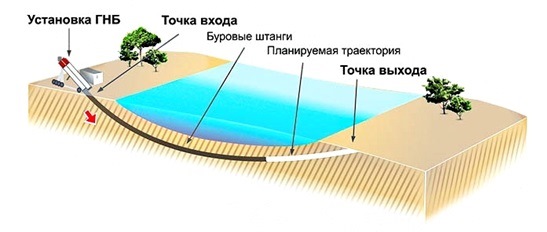
What is HDD in construction?
This technology allows trenchless laying of underground utilities, which is especially convenient if there are any obstacles on the site - for example, you need to lay a pipeline under an asphalt path or building. In this case, digging a trench not only takes more time, but also means that you have to either bypass the obstacle, or then put the site in order.
Sequencing
With the help of angle grinders, a piece of reinforcement up to 2 m is sharpened, and the sharpening should be uniform and maximum. When using a cut of more than 2 m, there is a high risk of bending.
Horizontal directional drilling can now be started directly. With the help of a sledgehammer, this segment is driven into the ground in the desired direction, and the blows must always be uniform.
After the segment is completely driven in, you need to weld the next one onto it. Thus, work is progressing to the required depth. When joining the rock, you can bend the rod a little, so you need to be careful. The work ends exactly at the moment when the working "head" appears at the exit point. In this way, the guide rod is formed.
Now a pipe with a larger diameter is taken and put on the reinforcement. On top of the pipe, another small segment of a slightly larger diameter (glass) is put on, which will protect the pipe from flattening upon impact, and after it is no longer necessary to beat, the glass should be removed. The pipe must be sharpened without fail with a grinder, so that the work progress is maximum.
After the pipe is driven to the very maximum (no more than 2 m), you need to install a pump with water in it and turn on the supply. To artificially increase the pressure, diameter reduction nozzles are used. Water will come out of the open part of the pipe, for which a 200 liter barrel was prepared.
When the work with the section is completed, you need to move the barrel to the side and empty it. Now you can weld on another cut on top and continue the activity in the same way until the exit of the pipe on the other side is fixed. It should be noted that one glass is used for the entire work.
Rig for horizontal directional drilling is quite expensive equipment. But if there is no financial opportunity to purchase such special equipment, then there is the option of making a mini HDD with your own hands. Such an idea is quite feasible, as many folk craftsmen have repeatedly proved, demonstrating their HDD installations at specialized forums. Such an installation is perfect for domestic use.
Let's see what is required to make such an installation, except for "straight hands":
- Welding machine;
- Grinding machine (grinder);
- Good sledgehammer;
- The reinforcement is at least 20 millimeters in diameter and ten centimeters longer than the road width. Steel pipes of the same length will also be needed;
- Pump with hose;
- A tub with a volume of at least 150 liters (a more spacious one is recommended) with a wide "neck";
- Drill, with which drilling will be carried out (you can also make it yourself);
- Funnel with a fixed hose at least 2 meters long.
Vertical drilling and bored piles
Today, rather large and voluminous residential and industrial buildings are increasingly being erected in areas with unstable soil.To transfer the main load to more stable soil layers, bored piles are used. Our company performs work on the installation of piles:
- Manufacturing of reinforcing cages and their immersion.
- Assembly of pile heads for the project elevation.
- Casing drilling with a diameter of 620 to 1500 mm.
- Wells concreting using VCT technology.
Bored piles are also used in dense buildings and in the city, since when performing work virtually no dust, noise, vibration or vibration.
The bored pile technology has several advantages, including:
- Durability and reliability.
- Strength.
- Stability, especially in areas with high seismic activity.
- Possibility of BNS device close to the foundations.
In addition, quite large loads can be transferred to one pile. During the work, there is no possibility of damage to the already laid communications.
Puncture method: advantages, technologies and cost
The soil is punctured using special equipment. The technology is currently the most demanded and popular way of conducting communications, especially in urban environments and areas with dense buildings.
The technology involves several stages. First of all, a well is performed, then it expands to a certain diameter, which must exceed the pipe section by at least 30%.
The third stage of the method involves tightening pipes or cases for the further laying of communication lines or electricity.
How to make a puncture with your own hands
In a domestic environment, if it is necessary to lay underground water supply or a small-diameter gas line into the house for a short distance, industrial passage techniques can be used.
One of the most effective types is hydro-puncture of a hole in the ground; for the following work, proceed as follows:
- They take metal pipes of the required diameter of 1 m. (A large pipe length will require a too voluminous place for work) for the entire length of the hole and cut a thread on them from one end, welded couplings with an internal thread of the same section and pitch to the other.
- To supply water, a submersible or surface electric pump is used, using an adapter sleeve, one end of which is attached to the pipe end, and the outlet of the pump unit is connected to the other.
- A pit of the required depth and length is dug in the ground, allowing it to conveniently place a steel meter of pipe in it for pushing through.
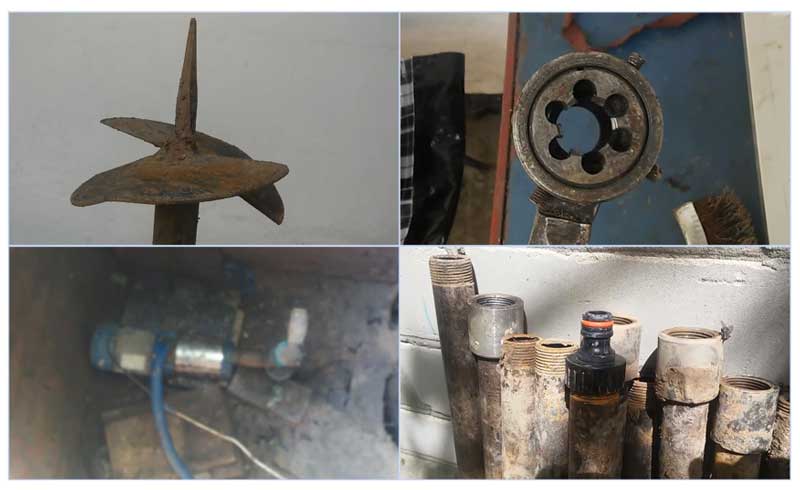
Rice. 8 Do-it-yourself hydro-puncture - equipment
- The well trajectory is calculated in advance, connects the pipe to the electric pump, supplies water and begins to push it into the ground, controlling the direction and deviation along the vertical by the building level.
- After deepening the first pipe, the electric pump is turned off, its branch pipe is disconnected and the second pipe is screwed onto the thread, connecting the electric pump from the other end and supplying water to it.
- The operation is periodically repeated until the full passage of the channel to the required length; upon completion of the work, the pipeline is removed and dismantled.
- A HDPE water pipe is inserted into the canal, taken to the right place and the work is considered complete.
For vertical laying of the mine in the house, a home-made drill is used, the length of which also depends on the depth of the line, it is turned with a drill or perforator.
Homemade drilling devices can be used for horizontal penetration in everyday life, while the rotation of the drill is carried out using an electric tool, extending it with metal rods with a threaded connection.
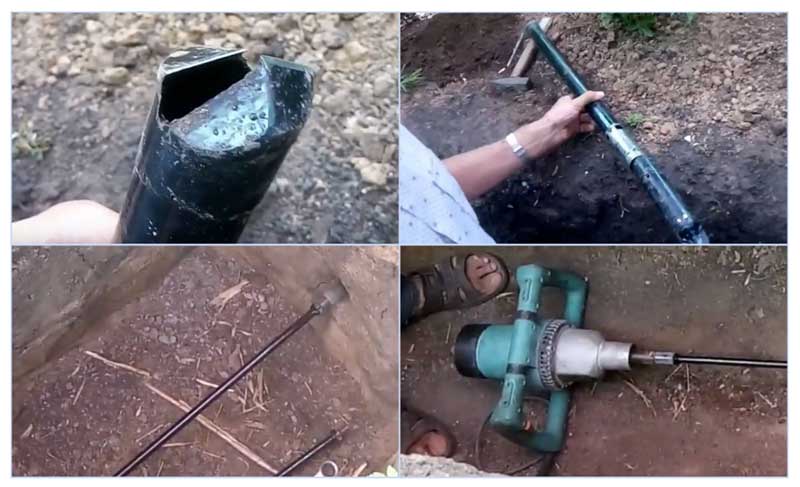
Rice. 9 Horizontal drilling with your own hands
Trenchless laying of pipelines is an effective method of solving problems in cases where digging trenches is impossible or economically impractical.When carrying out work, a wide range of industrial methods are used with the use of special equipment; some technologies can be successfully used in everyday life.
Features of trenchless technology
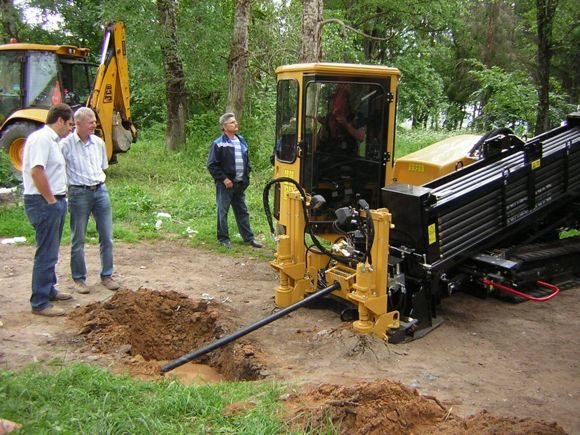
Even from the name it is clear that in this case there is no need to dig trenches. But in this case, we are talking only about the intersection of a road or railway bed, a reservoir. The pipeline route is brought to the facilities in the traditional way, but there it passes through the soil, so the road surface (or rails, sleepers) remains unharmed.
Advantages of the method
Trenchless laying of sewers or other engineering systems has undeniable advantages. These include:
- high efficiency;
- relative noiselessness;
- a small amount of preparatory work;
- paucity of service personnel;
- no need to block traffic;
- the ability to carry out work at any time of the year;
- complete absence of the risk of damage to other communications;
- lower costs when compared with the traditional trenching method;
- versatility: the technology makes it possible to lay a route in any terrain;
- reduction of the time required for the installation of systems, since this stage can be completed by professionals within a few days.
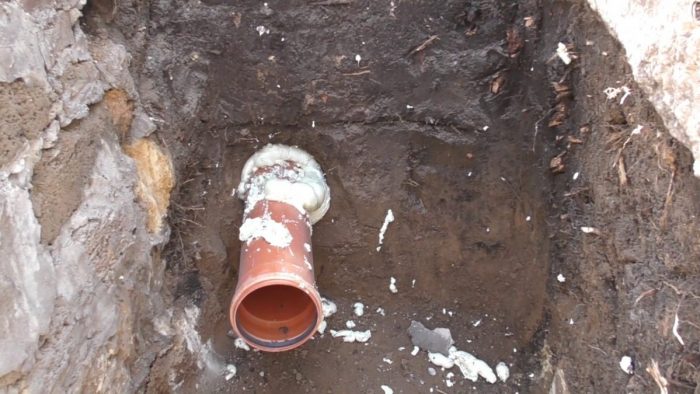
The main advantage of this technology is the absence of serious damage to the environment, because there is no need to restore the road surface.
Cons of technology
Are there any disadvantages? They are not, if we consider the method from the point of view of professional builders. Owners of suburban areas can find relative disadvantages even with trenchless laying. This is the need to hire special equipment and labor costs, when the operation is carried out without the participation of special equipment.
A small disadvantage can be considered the novelty of the technology, which in some cases may cause workers to be unaware of its features. Another potential problem is the lack of special equipment, but it is fixable.
Areas of use
After the invention of new trenchless methods, the need for a large amount of excavation has disappeared. For this reason, these technologies are widely used. To make sure that the methods are irreplaceable, it is better to get acquainted with their areas of application. Types of jobs:
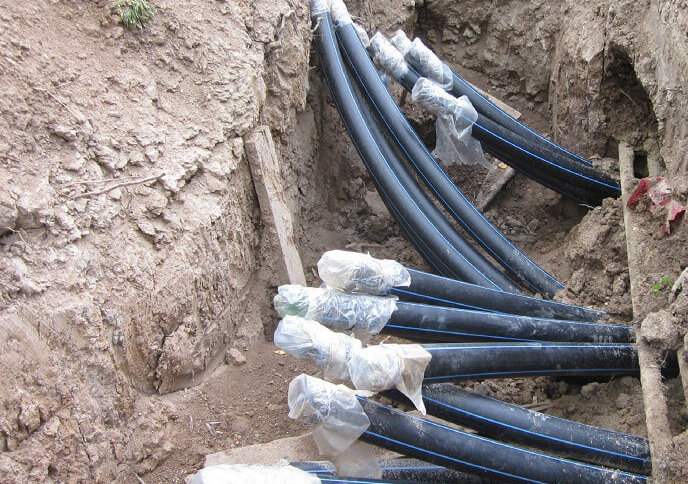
- laying of communication cables;
- trenchless sewerage installation;
- installation of underground heating mains, oil pipelines;
- laying of gas pipelines, water pipelines underground;
- repair or replacement of damaged line elements.
One of the types of trenchless laying (HDD) makes it possible to carry out communications in those places where the use of other methods is completely excluded. For example, if there is no chance for the entrance of large construction equipment, when there is a high probability of landslides in the area, etc.
Technique, materials for laying
Despite the fact that there are differences in methods, trenchless laying of sewers or other engineering systems is an operation during which the links of the pipeline are pushed into the ground. Therefore, most often they use a certain set of equipment. It includes:
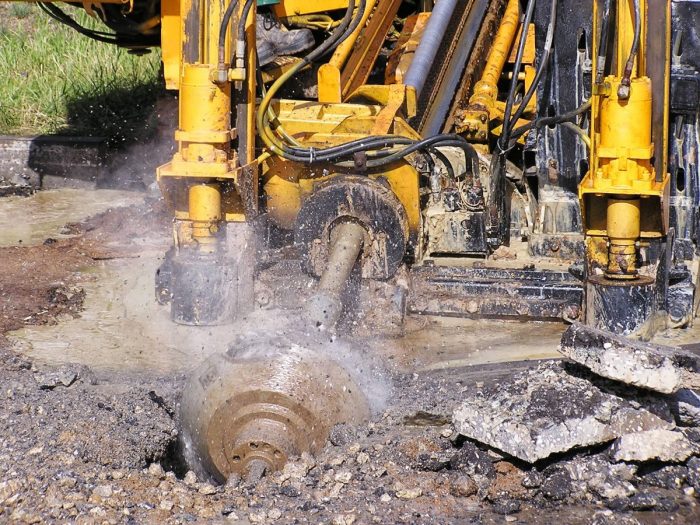
- installations for laying pipes: caterpillar or pneumatic;
- welding equipment for connecting line links;
- pipes, nozzles, drill heads, augers, rimmers;
- diesel hydraulic stations (oil stations);
- cameras, monitors for surveillance;
- bulldozers, winches, tractors;
- hydraulic jacks.
Each type of trenchless technology may require additional elements, as well as auxiliary equipment. It all depends on the characteristics of the soil, the characteristics and dimensions of the "surmountable obstacle".
What is Trenchless Piping and How It Works
The essence of the method is to conduct a highway under the surface of the earth, as opposed to digging surface trenches, which have the following disadvantages:
- The removal of soil leads to the destruction of the upper fertile layer not only in the trench, but also by special equipment, as well as to the contamination of the adjacent territory, which significantly increases the scale of damage.
- The trenching method damages plantings (trees, shrubs), which cannot always be restored.
- When carrying out work on asphalt roads and pedestrian roads, the asphalt pavement is destroyed, the use of routes becomes impossible and further repairs are required - this brings inconvenience and is economically unprofitable.
The advantages of the trench method include the simplicity of the technology available in households, and the prevalence of the technology used; also, high qualifications of workers are not required to dig trenches.
When using the trenchless method, the installation and laying of the pipeline is carried out using drilling equipment, through-feed units, hydraulic and pneumatic punches.
Technology advantages
Trenchless technologies, in contrast to other methods of engineering networks, have a number of advantages. Among them:
- Low cost. In case of a puncture after completing the work, it is not necessary to restore the asphalt surface and dig a trench.
- Minimal risk of damage to previously laid communications.
- Small time investment.
- The ability to carry out communications in dense buildings.
- The minimum amount of labor.
In addition, thanks to the trenchless communication method, the environment does not suffer. When laying utility networks, it is not required to disturb the topsoil and green spaces.
Horizontal directional drilling saves money and time. Unlike the trench method of carrying out communications, it is not required to dig a trench, which reduces the time of work. When puncturing the soil, it is not required to violate the integrity of the asphalt pavement, underground and ground communications.
Horizontal directional drilling does not require suspension of vehicle traffic and the operation of other communications.
The HDD method also allows you to reduce time, since you do not need to dig a trench. The speed of work is twice as fast. The cost of work when puncturing the soil, in contrast to other methods, is lower by 30-50%. This is due to the fact that digging trenches requires time and money, and does not require transportation and disposal of soil.
Carrying out a soil puncture when working with private customers requires the use of small diameter pipes. The length of the pipeline in this case is from 50 meters.
Directional drilling, HDD technology
Our company is a leader in the construction of horizontal directional drilling. We work with reliable suppliers. Our highly qualified specialists do the job quickly and efficiently.
HDD method when laying gravity sewer
Design and construction of sewerage systems using horizontal drilling in most cases is the only possible method of building an utility network. The company "AlfaEnergoMontazh" specializes in the arrangement of sewage systems using the HDD method, has the necessary drilling equipment and professionals with experience of successful work.
In the process of preliminary work when laying the sewage system in a trenchless way for the construction of a pipe channel, an expander is used, which makes a puncture 30-50% wider than the diameter of the planned pipe. Also in the process of laying bentonite is used to strengthen the walls and fix the pipeline. Due to the heterogeneous structure of the soil and the presence of groundwater, when laying the HDD sewage system, errors may be detected, which are eliminated at further stages.
If you need to drill a canal across the street at home
Horizontal drilling involves the use of specialized machines, but what to do when you need to lay a pipe (water supply or communications) to a private house across an asphalt road. There are two options for resolving the situation - call a team that will make a channel in a matter of hours, or build an installation with your own hands. Many people choose the first method, but the second method can also be implemented independently.
To make the installation yourself, you will need the necessary materials in the form of pipes. The principle of making a drilling rig with your own hands is as follows:
We take a steel pipe, the length of which must be at least half the distance of the road through which the pipeline is planned to be laid.
Teeth are made on the pipe head. Moreover, it is not necessary that the teeth be sharp, it is enough just to cut them with a grinder.
At the second end of the pipe, two through holes are made into which a metal bar or reinforcement is installed
It is important to understand that the larger the size of the rods, the less force will have to be applied.
The armature at the other end of the pipe should be gripped by hand and rotated in one direction to move the device. It is quite difficult, therefore, instead of hands, a powerful electric motor or a gasoline engine is used.
To connect the motor to the pipe, you need to make a gearbox to reduce the speed.

Such manual drilling of a hole under the road will require a lot of effort, but you will save on calling a specialized team.
Drilling a canal under the road at home does not present any difficulties, with the exception of physical ones. Otherwise, it is quite possible, and at the same time it will not be necessary to destroy the asphalt surface, for the restoration of which you will also have to pay.
When resorting to drilling a channel underground, it is important to remember about safety precautions, especially if you plan to use an installation connected to an electric motor. If you want to drill a channel manually, then the help of at least two strongmen will come in handy
In conclusion, it is worth noting that at home it is possible to drill a channel manually, using a sapper's shovel, but it will take a lot of time and effort. If such a need has arisen, then you need to assess your capabilities, and only then make the right decision. Whatever this solution is, you should try to make a canal across the road yourself, especially if its width does not exceed 10 meters. The smaller the width of the road, the easier it will be to cope on your own.
When calling for special equipment, you will have to pay for the work, and it does not matter how many meters you need to drill - 5 or 20
Channel expansion - the final stage
As soon as the drilling of the pilot canal is ready, you need to start the procedure for its expansion. The drill head is dismantled and a rimmer must be installed instead. This is an important structural element of the installation, which is used for laying the pipeline in a horizontal manner. This device serves to expand the pilot channel.

Rimmer helps to increase the diameter of the channel in the return path, that is, from outlet to inlet.
The expansion of the well is carried out before the utilities are laid. In the process of performing work, it is imperative to control that coolant is supplied to the drill. Interruptions in the supply of coolant will lead to overheating of the installation and failure of the geolocation equipment.
Phased implementation of HDD
The drilling process requires careful attention, control, adherence to technological features at every stage.
Preparatory work
Before laying underground utilities, the landscape and equipment must be prepared:
- Equipment of the platform for a drilling machine of universal size 10x15 m;
- If necessary - preparation of a bypass route for the car;
- Installation of drilling equipment and a pilot rod directly at the point of entry into the soil of the drill;
- Fixation of the tool with anchors on a flat surface to avoid displacement or mobility with HDD;
- Adjustment of the tool by the angle of inclination using the expander, alignment of the drill head for an even entry into the soil;
- Debugging radio communication between team members;
- In the pits, an additional outlet for bentonite fluid and groundwater is equipped if there are too many of them.
At the preparation stage, it is important to calculate the location of the existing pipelines so as not to damage them during excavation. When installing installations for mixing bentonite and drilling, it is necessary to maintain a distance between them, the minimum distance is 10 m
Before piercing, you should study the composition of the soil, select the appropriate tool for the successful passage of the drill head through the soil. The entire location of the work, where special devices are installed, as well as at the exit point of the drill, are fenced with a yellow warning tape.
Laying of pipelines and other communications
After carrying out preparatory work, proceed to HDD:
- A pilot well with a cross section of 10 cm is being laid;
- Debugging the equipment, adjusting the tilt of the drill head by 10 - 20 ° relative to the horizon line;
- Drill passage with checking the trajectory every 3 m and correcting the direction of the tool;
- Expansion of the pilot well: the original tool is removed from the puncture, replaced with a reamer;
- Full passage of the expander through the formed canal with constant movement correction.
With HDD, the use of drilling fluid is mandatory. The function of the composition includes softening the soil for the simplest passage of the tool through it.
It is important to consider the possibility of soil crumbling. To exclude a violation of the communication technology, it is necessary to connect all parts of the pipes together reliably so that soil pressure or crumbling fragments do not violate their integrity
We will select the installation for any type of HDD
We have been working in the HDD field for more than 10 years and will be able to select the optimal rig model for trenchless drilling, a complete set of drilling tools and consumables.
Still have questions? +7 (800) 350-20-26
Pros and cons of technology
Horizontal directional drilling was invented back in 1960.Since then, HDD has been actively used around the world due to the peculiarities of the technology. Like any technique, HDD has its own advantages and disadvantages.
Pros of HDD
- Less waste of resources, finances, labor;
- Compared to the method of trenching, it takes 30% less time;
- The costs of laying communications are reduced due to the absence of the need to restore the landscape;
- Work can be carried out in any territory, including the location of historical values, high-voltage stations, unfavorable climatic conditions;
- The structure of the soil is preserved, the fertile soil layers are not disturbed;
- At the time of the work, the usual urban rhythm is not disturbed, there is no need to stop the movement of cars, there is no harm to the environment.
The first thing to do is to agree on a construction project, reconstruction
It is not worth making a puncture under the road without a plan and approval, primarily for two reasons. The first reason is personal safety. It may turn out that certain types of communications that you did not know about already pass under your site. There were rare cases when the hidden pre-war communications were not known even after the project was approved. It is still worth insuring yourself so as not to puncture the gas pipe adjacent to your site - the consequences can be dire.
The second reason why it is better to make an agreement is a fine from city authorities for uncoordinated actions.This is especially true for those types of communications that go beyond your personal area: cases when you need to enter a common main pipe, etc.

Safety precautions: is it worth making a puncture yourself?
Immediately, we note in which cases it is not worth making a puncture under the road with your own hands: if the length of the required route is more than 10 meters, and also when there are already underground communications or difficult-to-pass sections on the territory.
On sandy, clayey and other soft soils, you can take a chance and do everything yourself if you have studied the area well enough. But in any case, you must prepare, study the technical part of the issue and be confident in your abilities.
When can a manual puncture be made:
- You have an engineering or construction background or a lot of practical experience in these areas in order to correctly assess the risks.
- You have approved a project for the construction or reconstruction of a house with a plan for future communications, you have approved the work.
- You are confident in your physical strength (especially when it comes to a mechanical puncture) or have several assistants.
- You have all the tools you need: jack, drill, pneumatic punch or mini HDD rig, welding machine, etc. (the choice of tools depends on the method of laying communications).
- You are ready to put in the effort, spend time learning technology, and do it yourself to save on costs.
- You have examined the soil and are confident that it is suitable for the selected puncture method. There are no underground utilities in the required area.
- The length of the underground route, which will be carried out by the puncture method, does not exceed 10 meters.
If you have doubts or do not want to thoroughly study the drilling methods, engage in soil exploration and other preparatory work that can take several weeks, it is better to contact the specialists. Skilled workers will cope with the task within 2-3 days without compromising the landscaped area. At the same time, companies give a lifetime guarantee for their work, which means that there will be no need to fear subsidence or collapse of the soil.
How the work is done
First of all, you should dig a pit from the spirit of the sides of the road. The depth depends on the level of the pipeline. It is from it that the pipes will move into the ground. One pit is the receiving pit, and the second is the main one.
The trajectory of the pipes is marked with a steel bar. The grinder sharpens its end. Using a sledgehammer or a heavy hammer, the rod is driven into the ground along the course of the pipeline. In order for the rod not to bend, its length should not exceed 2 meters. After one piece has completely entered the soil, a second piece is welded to it. The work must be continued until the steel bar appears in the receiving pit.
After the preparatory work, the pipeline is laid. To do this, a piece of pipe is put on the rod, the edge of which is pre-processed with a grinder. It needs to be given the shape of a cone, which will allow the pipe to freely enter the ground.
A special steel glass is put on the second end, which is hit with a sledgehammer. Then the hose is placed in a pipe and connected to a pump, which is lowered into a container of water.
With a high pressure, the liquid acts as a lubricant, which greatly facilitates the movement of steel in the soil, as well as washing out the soil that remains in the pipe cavity.
Subsequent work consists in alternating the above described actions. And it continues until a pipe appears in the receiving pit.
Thus, it is possible to puncture the road on the garden plot on your own. After the end of the work, a guide tube with a rod should appear in the pit, which should be removed after the work has been completed.
The laid pipeline is used as a casing. Pipes of a smaller diameter are pulled into it.But in the case when the length of the pipeline is more than 10 meters, you should contact a specialist, since it is rational to use a special puncture technique.
HDD method of pipe laying
Over its 50-year history, horizontal directional drilling in pipeline construction has gained serious popularity. Everywhere, governments of different countries are adopting HDD as the main method of laying pipes.
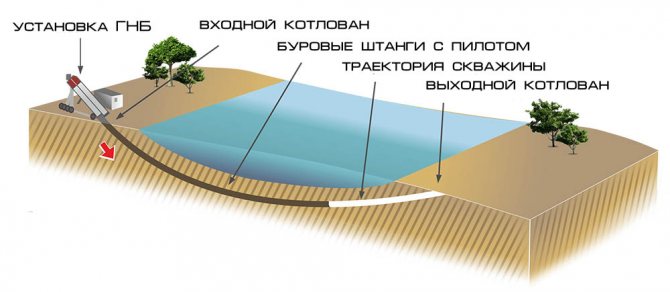
The HDD method is a method of trenchless laying of communications by horizontal drilling of the soil. The main advantages of the method: efficiency, cost reduction and preservation of the integrity of the earth's surface at the installation site. Such work is carried out using specialized drilling equipment - HDD rigs.
Today, the closed method of laying engineering communications has become the main one. Leading construction companies in the USA, Canada, Europe and China are gradually abandoning trenching in favor of closed pipe laying. But such popularity of HDD technology did not come immediately.
Historical aspect
In the second half of the 20th century, after the end of the Second World War, sharp urbanization and population growth began. The streets of the cities were filled with motor transport, new high-rise buildings grew like mushrooms after rain. All this led to the development of pipeline networks. The active laying of various pipeline connections began. Pipelines, like spider webs, enveloped cities on all sides. The builders faced constant problems when laying: the intersection of highways, residential buildings, rivers, lakes. We had to stop traffic and carry out large-scale excavation work.
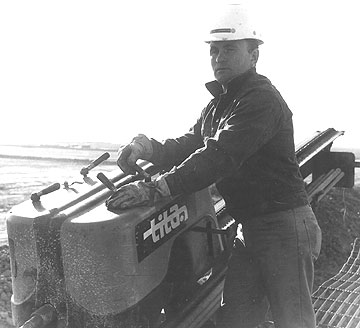
It was at this moment that the time came for the HDD method of pipe laying. This idea came to the mind of the American Martin Cherrington, when he was fulfilling one of the orders for laying a cable in the vicinity of Los Angeles. In 1964, enthusiastic Martin invented his first horizontal directional drilling rig. In 1971, the HDD method of pipe laying fully proved its effectiveness when Martin's company completed an order for laying a gas pipeline under the river. At that time, there were no geolocation systems yet, and ordinary water was used as the drilling fluid. However, the HDD method has proven to be highly effective and has begun to be used in countries other than the United States. It is known that this method was also used by Soviet specialists in the 1980s, during the construction of the Baikal-Amur Mainline.
Puncture as one of the HDD methods
Horizontal directional drilling is not the only way to install pipelines without trenching. A less popular, but also effective method for the closed laying of underground utilities is a horizontal puncture. However, it is difficult to call this method completely trenchless, since you still have to dig two parallel pits.
After the preparation of the pits, the soil is punctured in the direction from the working pit to the receiving pit. Vibration puncture is performed using a special vibratory hammer.
Punching
Punching is another method of HDD pipe laying. If, during a puncture, the soil was pressed into the walls of the well, then in this case, it enters the pipe. Directly pushing the pipe is carried out using a jack mechanism. Usually, the punching length does not exceed 100 meters. This method is used much less frequently than horizontal directional drilling.
Pipe driving method
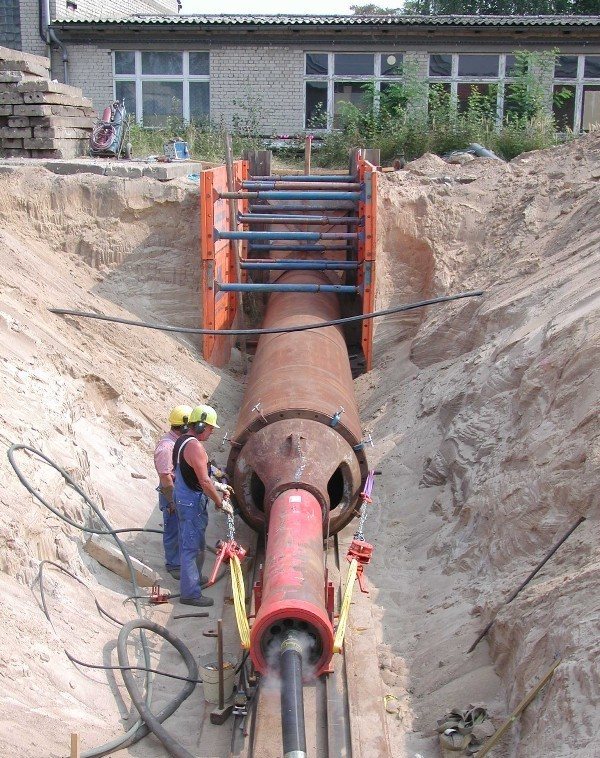
This method also allows you to do without digging trenches, however, due to its imperfection, it is used extremely rarely. The method can only be used with high strength pipes (steel, for example).The essence of the driving method is as follows: the pipe being laid is pressed into the soil by force with an open end, on which a knife device is fixed for pushing the soil. The compressed soil is removed from the pipe manually.
In conclusion, it should be said that the HDD method is a unique method that will be out of competition in the construction of underground communications in the near future.
Benefits of trenchless installation
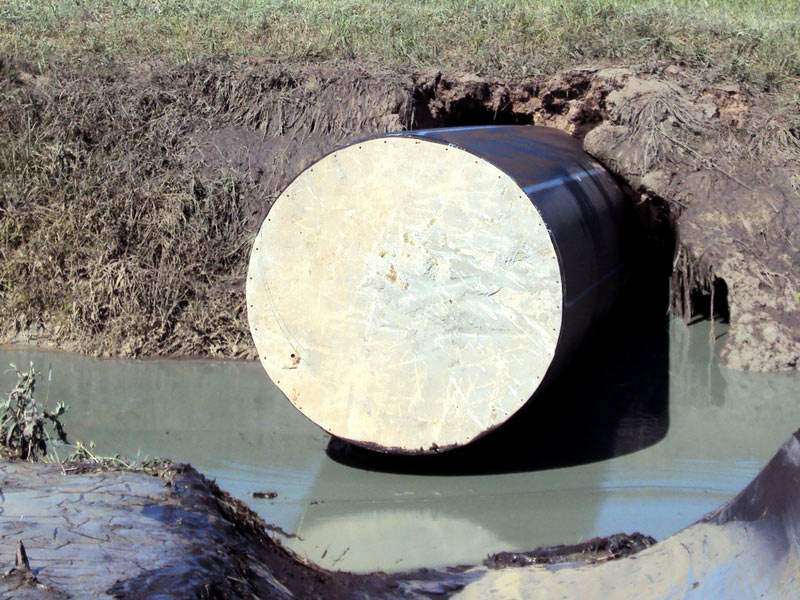
Despite all of the above, it is worth separately grouping all the positive points regarding the issue of laying the HDD water supply system. So, the advantages of using this method, rather than an open strip, include:
- no need to block road, pedestrian and bicycle roads during work;
- reduction in financial costs due to the unnecessary need for additional excavation of the trench, if the water supply system needs to be installed at a depth exceeding several meters;
- does not require work to create drainage when a high level of groundwater is observed at the installation site;
- during the laying process, there is no need to create a sandy base for laying the pipe;
- no need to use a sand seal, since the pipes are not backfilled, but installed directly in the ground at the required depth;
- work on the improvement of the adjacent territory is required minimal;
- there is no need to cut down green spaces.
Accordingly, the method that uses trenchless installation of water pipes is an excellent alternative to the option of open laying of communications, which significantly reduces the time of work, as well as financial costs.
And if the economic component of the described method is so obvious, are there any serious reasons to abandon the use of modern technologies?
How to make a puncture with your own hands
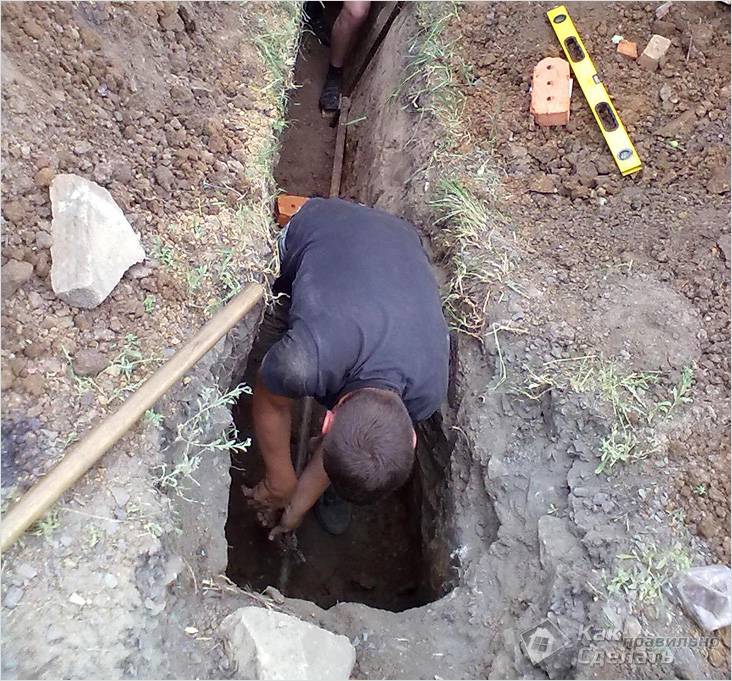 Self-piercing soil The practical implementation of the do-it-yourself trenchless pipe-laying method is possible only in a relatively short section (no more than ten meters), as well as if you are in good physical shape, which would allow you to perform heavy working operations. As for the equipment necessary for such work, then you will definitely need the following simple tool:
Self-piercing soil The practical implementation of the do-it-yourself trenchless pipe-laying method is possible only in a relatively short section (no more than ten meters), as well as if you are in good physical shape, which would allow you to perform heavy working operations. As for the equipment necessary for such work, then you will definitely need the following simple tool:
- the simplest welding machine;
- the usual "grinder";
- small sledgehammer;
- reinforcement is not thicker than 20 millimeters;
- steel pipe of your chosen diameter (several pieces);
- a pump equipped with a plastic pipe;
- plastic barrel with a neck (capacity up to 200 liters);
- funnel with a hose up to 2 meters long.
The trenching process usually includes the following steps:
- Preparing a ditch on both sides of the track (with a margin of 12-13 cm). When digging it, the axis of the pipe that you plan to lay is outlined.
- After that, a pipe blank is taken and its end is sharpened, which is intended to be driven into the ground. In this case, it is best to cut teeth on it using a "grinder".
- As you carry out all these operations (after each next pushing the pipe), you should wash out the soil from its hollow part.
- After each next "flushing" of the pipe, continue driving it with a sledgehammer.

